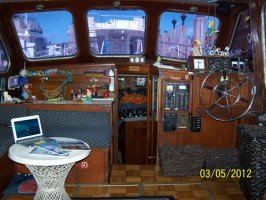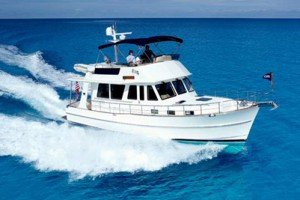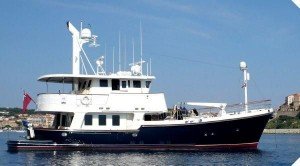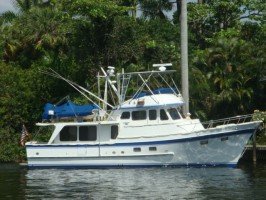Archive for November 5, 2013
Trawler Accommodations and Layouts
November 5, 2013 I have written many blogs concerning Trawlers and I would like to take this time to address interiors. It’s nice to have adequate space while cruising and living aboard. Most accommodations consist of a salon, one, two, or even a three stateroom layout, one or two heads, not excluding the engine room.
I have written many blogs concerning Trawlers and I would like to take this time to address interiors. It’s nice to have adequate space while cruising and living aboard. Most accommodations consist of a salon, one, two, or even a three stateroom layout, one or two heads, not excluding the engine room.
Salons:
Salons are one of the most desirable features enjoyed by owners. Salons are oversized with extra large windows providing a 360-degree panoramic view. Trawler interior’s normally come with wonderfully hand carved teak trim, it is well appreciated and provides a warm environment. Don’t be surprised to find parquet teak floors with built in L shaped settees, high/low teak tables with the up position for dinning and the down position that converts to a cocktail or coffee table, this allows more space when needed. The Salon is the most important room on the trawler and it is where all of your entertainment will take place and where you will spend the majority of your time
Staterooms:
Trunks and Sundeck trawlers have separated staterooms which is great for privacy, each with it’s own head and shower. The master stateroom, being aft, normally has a centerline berth. The centerline is very popular and easy to make up, whereas the offset is up against the wall and when sleeping together when your mate has to use the bathroom, you must crawl over your partner and most likely disturb their sleep. The offset layout is popular with ocean going trawlers, due to its design, it is harder to fall off in stormy sea’s.
The guest state room being forward, the berths could be offset. You can a have bunk bed, twin down and a single up or the centerline berth. I happen to like the bunk design as it houses a brother/ sister, two men, two women, husband/wife etc., giving you a broader choice of sleeping arrangements. Please note when buying a trawler do not put to much stock in selecting your stateroom, just think about the fact you are only in it 5% of the time and 4% of that you are sleeping leaving 1% of time in the stateroom. The Sedan and Pilothouse have staterooms amidships and up front where you lose much of your privacy and usually has one head 45′ and under the head is also located in that area.
Galley:
Galley up is flush with the salon. while cooking you are in the same area and floor level as your guest. You have a full view looking out of the salon windows when cooking. The disadvantage of the galley up is it being flush with the salon, hence the two become one with no sense of separation. The person doing the cooking may want galley up so they are not isolated from their partner or company making this is a very popular choice.
Galley down ensures a spacious main salon. Some may like the separation between the galley and salon, it gives you a sense of privacy while cooking and you are separated from others. Another thing I would like to make you aware of is you have steps going up and down to deal with.. Some galley down styles have a separate dinette table with either bench seating or u-shaped seating across from the galley and the table can convert to a drop down bed. Some styles may also have a common head in this area.
Heads:
Heads are normally connected to your staterooms. The master with it’s own private head. The guest room will most likely have a common head meaning it has two doors one to the stateroom and the other in a common area for passenger’s to use. Heads can have a shower not being separated, it will wet the entire head. A separate shower installed will keep the rest of the head dry. Showers can come with half or full tubs.
Written by Captain Robert Hamilton aka Captain Bob.
For more blogs and information on Trawlers please visit www.trawlerschoolcharters.com.
You can contact me at trawlerschool@gmail.com or call 954-649-9611
Trawler Size
November 5, 2013 Before you choose a trawler size , you must have a clear agenda on what model trawler Trunk, Sundeck, Sedan or Pilothouse and how you intend to use your vessel, as well as what is comfortable for your needs.
Before you choose a trawler size , you must have a clear agenda on what model trawler Trunk, Sundeck, Sedan or Pilothouse and how you intend to use your vessel, as well as what is comfortable for your needs.
30′ — 35′: This length trawler is a fun day cruiser, fine for inland and light offshore use. Accommodations are comfortable enough for two people on overnight and weekend boat cruising, in terms of size, it’s an comparable to a pup tent. I personally have met trawler owners that have completed the big circle and Caribbean cruising weather permitting.
36′ — 40′: Easy enough for one to two people to handle with a minimum amount of experience; this size has enough beam for stability to under-take light and medium offshore cruising. This size vessel also has sufficient range for traveling. Equipped with adequate guest accommodation and cruising equipment extended cruising is possible. It is large enough to live aboard comfortably, think of it as the size of a condo.
40′ — 44′ A nice size trawler, the beam gives this length boat adequate stability and offshore seaworthiness. Two people with intermediate boating experience can still handle this trawler. This is the most popular size trawler on the market for both comfort and sea handling ability. It is like living in a single family home.
45′ & Larger: These are your serious long – range cruisers. This length should provide enough weight, beam and fuel capacity along with plenty of room for the serious cruiser. Accommodations can be luxurious and navigational equipment sophisticated. A mansion sized vessel suitable for the more experienced cruiser.
For more article’s written by Captain Robert Hamilton (Captain Bob) go to www.trawlerschoolcharters.com Dania Beach
Passagemaker the Ocean Crosser
November 5, 2013 There are four types of trawlers, Trunk, Sedan, Sundeck, Pilothouse. Then there is the Passagemaker it is a heavy duty, well built, long range ocean crossing trawler. Passagemakers are clearly defined as being able to ”make the passage”. This trawler is completely set up for Trans-ocean crossings. a full displacement hull most likely starting at 50′ and up having features not found on regular trawlers. Using such a trawler for local, inland or coastal and Island cruising would be overkill and a waste of money. Passagemakers are used for extremely long range open ocean crossings. The high seas mates!
There are four types of trawlers, Trunk, Sedan, Sundeck, Pilothouse. Then there is the Passagemaker it is a heavy duty, well built, long range ocean crossing trawler. Passagemakers are clearly defined as being able to ”make the passage”. This trawler is completely set up for Trans-ocean crossings. a full displacement hull most likely starting at 50′ and up having features not found on regular trawlers. Using such a trawler for local, inland or coastal and Island cruising would be overkill and a waste of money. Passagemakers are used for extremely long range open ocean crossings. The high seas mates!
First and foremost, range is a concern. Depending on what part of the world you plan to cruise, you must find your longest leg first. For instance, a Trans-Atlantic crossing from Bermuda to the Azores is about 1,850 miles, and a Pan-Pacific crossing from San Diego to Hawaii is about 2,300 miles, in order to establish your fuel tank capacity you must do your arithmetic and calculate your range leaving about 10% — 15% fuel in reserve to be safe.
The “Raised” pilothouse cabin should be well forward towards the bow and up high for the captains best view and totally separated from the rest of the boat.. You want to have a total blacked out effect for night vision on such long voyages. Reversed-raked windshield’s helps reduce the glare. Window thickness is important for safety from pounding waves, storm shutters at the ready for total protection when needed in foul seas.
A Portuguese Bridge is a fixed solid U shaped structure wrapping around the front of the pilothouse cabin to the side access doors. This provides excellent protection from being washed overboard when the watch stander must go on deck, it also provides good protection from waves smashing over the bow in heavy seas.
Engine room – the more room the better and most have stand up rooms, also some have work bench and lots of storage for tools and spare parts. easy access is important for ongoing inspections while underway.
We covered range and heavy-duty hull construction for seaworthiness. Now for all the bells and whistles (options), you can add some of the following for your convenience, comfort, safety and especially cost.
Today’s new technology has really allotted comfort and convenience to the blue water ocean crosser for those that can afford these options/equipment, making there voyages more enjoyable, safer with less fatigue administered to the Captain and crew on hand. Communication’s, sitcom, portable cell phones, emergency positioning locators, advanced emergency safety equipment, chart plotters, GPS, SSB, weather fax, water makers, stabilizers, computers, emergency auxillary get home system’s are just some of the options adding to the comfort and safety. Why take unnecessary risks?
Some owners either don’t have the budget or the desire for some of these option’s. You’ll be surprised at some of the old salts (not me) looking for adventure on the high sea’s roughing it one leg at a time finding it exhilarating that only the heartiest shall survive. It has been done for centuries with only a sexton on board.
Written by Captain Bob Trawler School Charters Dania Beach Florida
for more information go to www.trawlerschoolcharters.com
trawlerschool@gmail.com Captain Robert Hamilton
Sea U
Captain Bob
Pilothouse Trawler
November 5, 2013 There are four types of trawlers: Trunk, Sundeck, Sedan and the Pilothouse. The pilothouse style has a hansom design and go anywhere sea- salty look. Thee Pilothouse has long been popular with northern boaters and favored by experienced yachtsman for it’s “Pilothouse” and weather protected helm. In recent years we have seen their popularity grow in warmer climates where many admire their “business like” appearance. There are two types of Pilothouse trawlers; the raised and the flush deck.
There are four types of trawlers: Trunk, Sundeck, Sedan and the Pilothouse. The pilothouse style has a hansom design and go anywhere sea- salty look. Thee Pilothouse has long been popular with northern boaters and favored by experienced yachtsman for it’s “Pilothouse” and weather protected helm. In recent years we have seen their popularity grow in warmer climates where many admire their “business like” appearance. There are two types of Pilothouse trawlers; the raised and the flush deck.
The flush deck is not separated from the salon and offers no privacy. It also does not offer the view provided by the raised Pilothouse. The raised pilothouse provides operation of the vessel in complete privacy and is separate from the rest of the boat. This design is normally equipped with an overnight watch berth, a settee/dinette, a state of the art navigation station and is known for it’s excellent forward and lateral visibility providing excellent night vision. Some Pilothouse’s are equipped with raked windows, also known as slanted windows to help stop instrument glare at night and reflect pounding waves. Port and starboard doors are split as a top and a bottom (commonly know as Dutch doors) so you can open the top and lookout in safety. The Portuguese bridge is a fixed solid structure with a high coaming surrounding the Pilothouse providing excellent protection from being washed overboard when the watch stander must go on deck. It also provides excellent protection from waves crashing over the bow in heavy seas. The typical floor plan consists of cockpit access doors leading to the salon on the same level. The master stateroom with private head is generally located amidships, directly below the raised Pilothouse. The guest stateroom or staterooms are forward of the master stateroom along with a separate common head. Some models have aft cockpit ladders that lead to the fly bridge and some with steps inside the Pilothouse leading to the fly bridge. A few models have no fly bridge.
In my opinion I consider it a must, as not having one is a negative on a resale.The fly bridge normally embodies an extended deck with a mast and boom with an electric davit to hoist the dingy to it’s storage rack. The extended deck provides shade and protection over the aft cockpit and decks. The upgraded version of the Pilothouse is the Passagemaker, a better built, more expensive rugged model and is best suited for long range ocean cruising I hope this article gives you a better understanding of the Pilothouse trawler, however, getting onboard will be your next step if the Pilothouse sounds like it would fit your future needs.
Captain Robert Hamilton (Captain Bob)
at www.trawlerschoolcharters.com
Dania Beach Fl trawlerschool@gmail.com
PS – For more information on learning about trawlers please click here